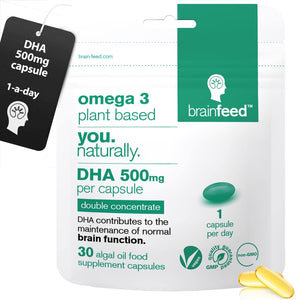What is neuroplasticity and how does it work?
filter
Years ago it was widely believed that brain tissue is a fixed structure, unable to change. Luckily, brain research keeps advancing and now a huge body of research shows that the brain changes continuously throughout life in response to everything you do and every experience you have[1].
Your brains best kept secret: What is neuroplasticity ?
The brain is a complex organ that controls every process that regulates your body such as emotion, touch and breathing[2]. A type of cell called a neuron receives and sends messages from the body to the brain and back to the body. Different neurons message each other to help the body function as it should[3]. When you grow old, neurons grow old with you, although your brain can still function properly. Wondering what is brain plasticity? Neuroplasticity can be defined as the brain’s ability to change, remodel and reorganise for a better ability to adapt to new situations[4]. To illustrate this, imagine your brain as a film camera. A unique sailboat has come into the shot making for a great photo opportunity. When you press the shutter button, the film is exposed to new information: The colour of the boat, the sailors on board, and the number of sails. However, to retain this information, the film must react to the light it’s suddenly exposed to and change. The same must happen in your brain. If you want to remember something, changes must occur in the brain that represent what you want to remember; new connections are formed between neurons in the brain that essentially remap the organ. And that’s neuroplasticity. It involves many different processes that take place throughout life.
Brain plasticity & adapting to the world
What is neuroplasticity and how does it work? Neuroplasticity is an umbrella term encompassing different ways in which the brain can change[5]. It refers to the brain’s ability to undergo adaptations in response to experience, and this process is associated with improvements in cognitive function[5]. Let’s go back a few years and think about making prints in a colourful plasticine. If you press a Lego into it, a cube with circles will be imprinted in it. In order to preserve the image of the cube the plasticine must change and its building blocks must be redistributed accordingly under the Lego. Similarly, networks in the brain remodel in response to an experience. For example, when London taxi drivers successfully learn a mental map of London's streets, structural changes happen in the brain affecting memory and creating a greater volume of nerve cells in the middle deep part of the brain.
Everybody wants to keep their brain younger for longer so here are some neuroplasticity exercises you can implement to help keep your brain healthier for a longer time.
-
The power of language
Try to learn one new word every day. According to experts, this simple act will spark a multitude of new neural pathways, both visual and auditory[6]. Give it a few months and it’ll make you unstoppable at Scrabble too.
2. A "handy" tip
Exercises you do with your non-dominant hand are excellent for forming new neural pathways and strengthening the connectivity between existing neurons[7]. For instance, try brushing your teeth with your left hand if you're right-handed.
3. Train your brain
Mnemonics are strategies used to improve memory. They are often taught in school to help students learn and recall information. Using strategies that aid information recall to teach yourself formulas or rhymes, can enhance connectivity in your prefrontal parietal network, paving the way to new, positive pathways in your brain[8]. Let’s say you’re trying to expand your vocabulary by learning a new word in a new language[9]. You're trying to learn the Italian word for a male cat which is gatto. First, think of a gate and then imagine the cat sitting on top of the gate. Even though the "a" sound in gatto is short and the "a" sound in the word gate is long, the beginnings are similar enough to help you remember the association between gate and cat and to recall the meaning of gatto.
Neurogenesis: making way for new cells
Neuroplasticity occurs in the brain during normal development in childhood and adulthood and as an adaptive mechanism to compensate for the loss of function upon injury to preserve that function[4]. The term neuroplasticity can be broken down into two significant mechanisms; regeneration and reorganisation[10]. So, what is neurogenesis? It’s a term that describes neurons’ ability to adapt by regenerating[10]. Baby cells also known as immature cells that are yet to be given a role in the brain can transform into new neurons in a very simple process that other cells are incapable of[11]. Why is that important, you ask? Scientists believe that treatment with immature cells could help people with diseases such as Alzheimer’s dementia or Parkinson’s disease which cause a shorter lifetime of neurons in certain parts of the brain[11]. They believe that harnessing the power of neurogenesis and neuroplasticity could help heal the damage.
Food for thought
Your brain makes up a tiny proportion of your total body weight, but it uses up a quarter of everything you eat. If you want enhanced neural pathways, you’ll need an enriched diet. So, how to improve neuroplasticity exactly? Diet is a lifestyle factor known to influence brain structure and function that boosts neuroplasticity mechanisms[12]. Caloric restriction has also been shown to have positive implications for reducing the risk of developing Alzheimer’s Disease[13]. Studies examined the supplementation of omega-3 fatty acids found in algae and fish, catechin polyphenols found in fruits such as apples and blueberries, and curcumin[14,15]. Researchers found out that those nutrients support cognitive processes[14] and exert neuroprotective effects[15]. brain feed has developed a sustainable and plant-based omega 3 supplement that provides you with 500mg of DHA in just one vegan soft-gel capsule. Use code ‘NEW15’ to get 15% off your first purchase.
Sweat your way to a healthier brain
Evidence has suggested that aerobic and resistance training contributes to exercise-induced neuroplasticity[16]. Studies have found that improvements in cognitive domains including attention, processing speed and working memory are more remarkable following a combination of aerobic and resistance training than either form of training alone[17,18]. So, how to increase neuroplasticity? A study from Korea showed that 6 months of performing combined aerobic and resistance exercise training increased the levels of BDNF in healthy middle-aged women[19]. NHS recommends that you do strengthening activities that work on all the major muscle groups at least 2 days a week and do at least 150 minutes of moderate-intensity activity or 75 minutes of vigorous-intensity activity per week[20]. Examples of moderate-intensity activity include brisk walking, riding a bike and dancing while vigorous activities are swimming, aerobics and walking up the stairs. Muscle-strengthening activities include carrying heavy shopping bags, weight-lifting and yoga.
Keeping your brain healthy is in your hands. Make sure to eat right and exercise your body and mind to keep your brain in shape.
References
[1] Lillard, A. S., & Erisir, A. (2011). Old dogs learning new tricks: Neuroplasticity beyond the juvenile period. Developmental Review, 31(4), 207–239.
[2] Brain Anatomy and How the Brain Works (n.d.). Johns Hopkins Medicine. https://www.hopkinsmedicine.org/health/conditions-and-diseases/anatomy-of-the-brain#:~:text=The%20brain%20is%20a%20complex,process%20that%20regulates%20our%20body.
[3] Ludwig, M. (2017). How Your Brain Cells Talk to Each Other—Whispered Secrets and Public Announcements. Frontiers for Young Minds. https://kids.frontiersin.org/articles/10.3389/frym.2017.00039
[4] Demarin, V. & Morović, S. (2014). Neuroplasticity. Periodicum biologorum, 116 (2), 209–211.
[5] Costandi, M. (2016). Neuroplasticity. Massachusetts Institute of Technology.
[6] Mohr, B. (2017). Neuroplasticity and Functional Recovery after Intensive Language Therapy in Chronic Post Stroke Aphasia: Which Factors Are Relevant? Frontiers in Human Neuroscience, 11, Article 332.
[7] Frizzell, T. O., Phull, E., Khan, M., Song, X., Grajauskas, L. A., Gawryluk, J., & D’Arcy, R. C. N. (2022). Imaging functional neuroplasticity in human white matter tracts. Brain Structure and Function, 227(1), 381–392.
[8] Conde, S. (2018). Method of Loci and the Aging Mind: How a Visuospatial Mnemonic Device May Help Prevent Sub-Clinical, Age-Related Memory Decline [Term paper].
[9] Li, P., Legault, J., & Litcofsky, K. A. (2014). Neuroplasticity as a function of second language learning: Anatomical changes in the human brain. Cortex, 58, 301–324.
[10] Puderbaugh, M. & Emmady, P. D. (2023). Neuroplasticity. StatPearls. https://www.ncbi.nlm.nih.gov/books/NBK557811/#:~:text=Neuroplasticity%20can%20be%20broken%20down,as%20equipotentiality%2C%20vicariation%2C%20and%20diaschisis
[11] Campbell, C. (n.d.). Can brain cells regenerate? Centre of the Cell. https://www.centreofthecell.org/blog/science-questions/can-brain-cells-regenerate/#:~:text=Science%20has%20since%20discovered%20that,new%20neurons%20without%20using%20mitosis.
[12] Pickersgill, J. W., Turco, C. V., Ramdeo, K., Rehsi, R. S., Foglia, S. D., & Nelson, A. J. (2022). The Combined Influences of Exercise, Diet and Sleep on Neuroplasticity. Frontiers in Psychology, 13, 831819.
[13] Luchsinger, J. A., Tang, M.-X., Shea, S., & Mayeux, R. (2002). Caloric Intake and the Risk of Alzheimer Disease. Archives of Neurology, 59(8), 1258.
[14] McCann, J. C., & Ames, B. N. (2005). Is docosahexaenoic acid, an nϪ3 long-chain polyunsaturated fatty acid, required for development of normal brain function? An overview of evidence from cognitive and behavioral tests in humans and animals. The American Journal of Clinical Nutrition, 281, 281–295.
[15] Murphy, T., Dias, G. P., & Thuret, S. (2014). Effects of Diet on Brain Plasticity in Animal and Human Studies: Mind the Gap. Neural Plasticity, 2014, Article ID 563160.
[16] Loprinzi, P. D., Moore, D., & Loenneke, J. P. (2020). Does Aerobic and Resistance Exercise Influence Episodic Memory through Unique Mechanisms? Brain Sciences, 10(12), 913.
[17] Colcombe, S., & Kramer, A. F. (2003). Fitness Effects on the Cognitive Function of Older Adults: A Meta-Analytic Study. Psychological Science, 14(2), 125–130.
[18] Smith, P. J., Blumenthal, J. A., Hoffman, B. M., Cooper, H., Strauman, T. A., Welsh-Bohmer, K., Browndyke, J. N., & Sherwood, A. (2010). Aerobic Exercise and Neurocognitive Performance: A Meta-Analytic Review of Randomized Controlled Trials. Psychosomatic Medicine, 72(3), 239–252.
[19] Cho, H. C., Kim, J. K., Lee, N. J., Kim, S. Y., & Yoon, N. K. (2014). Effects of combined exercise on cardiovascular risk factors and serum BDNF level in mid-aged women. Journal of Exercise Nutrition and Biochemistry, 18(1), 61–67.
[20] Physical activity guidelines for adults aged 19 to 64 (2021). NHS. https://www.nhs.uk/live-well/exercise/exercise-guidelines/physical-activity-guidelines-for-adults-aged-19-to-64/


 alertness
alertness
 cognition
cognition
 sleep
sleep
 wellbeing
wellbeing


Leave a comment
Open tab